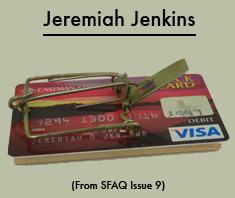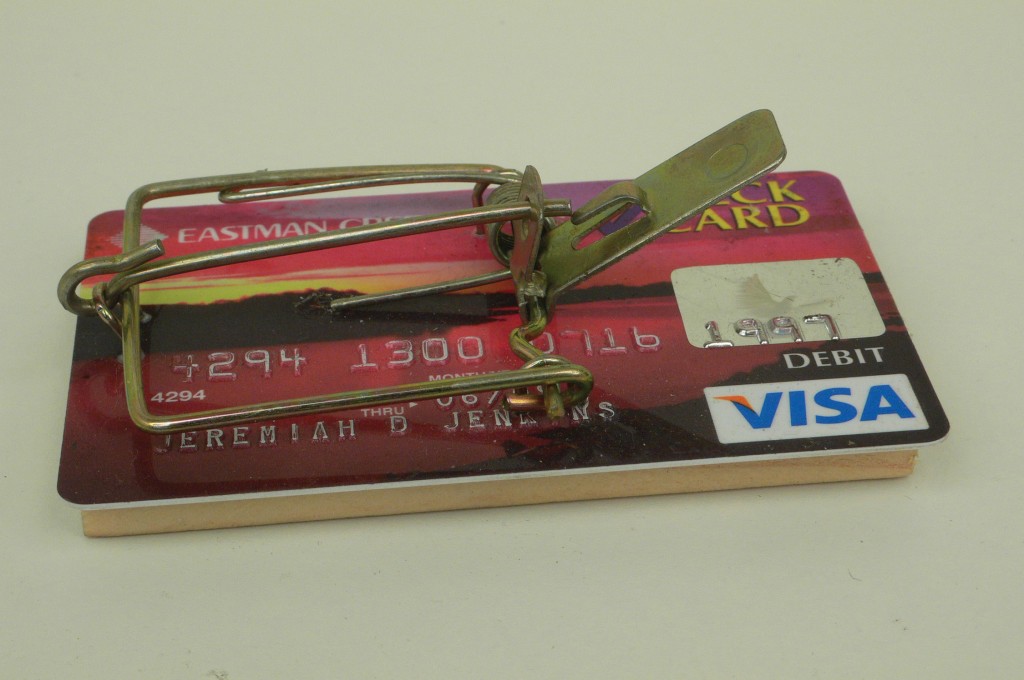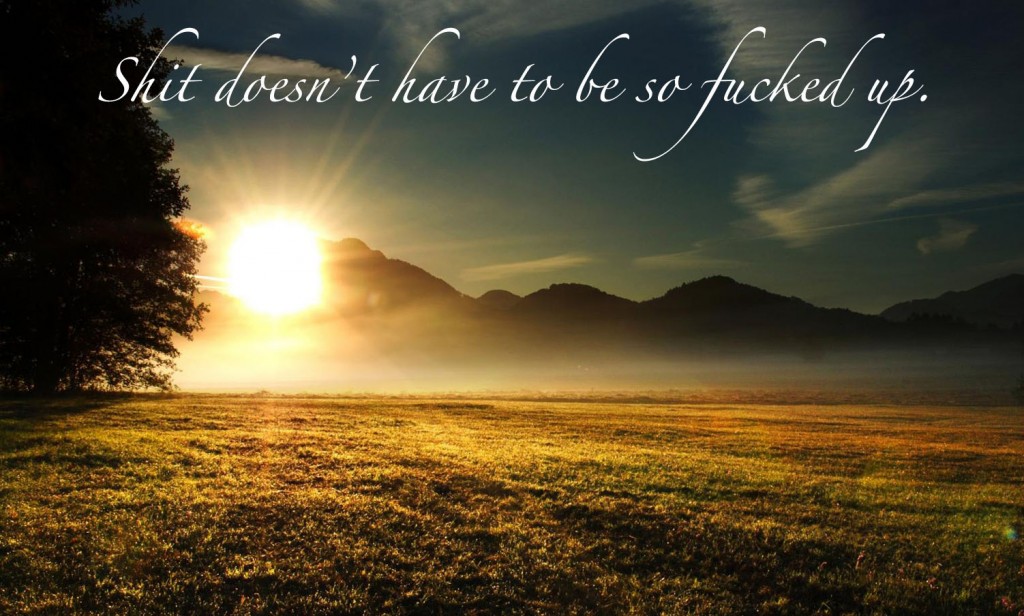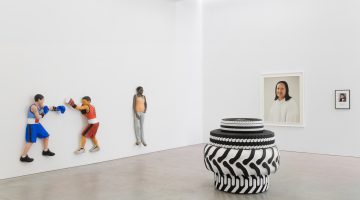Jeremiah Jenkins
Interviewed by Michael Nissim
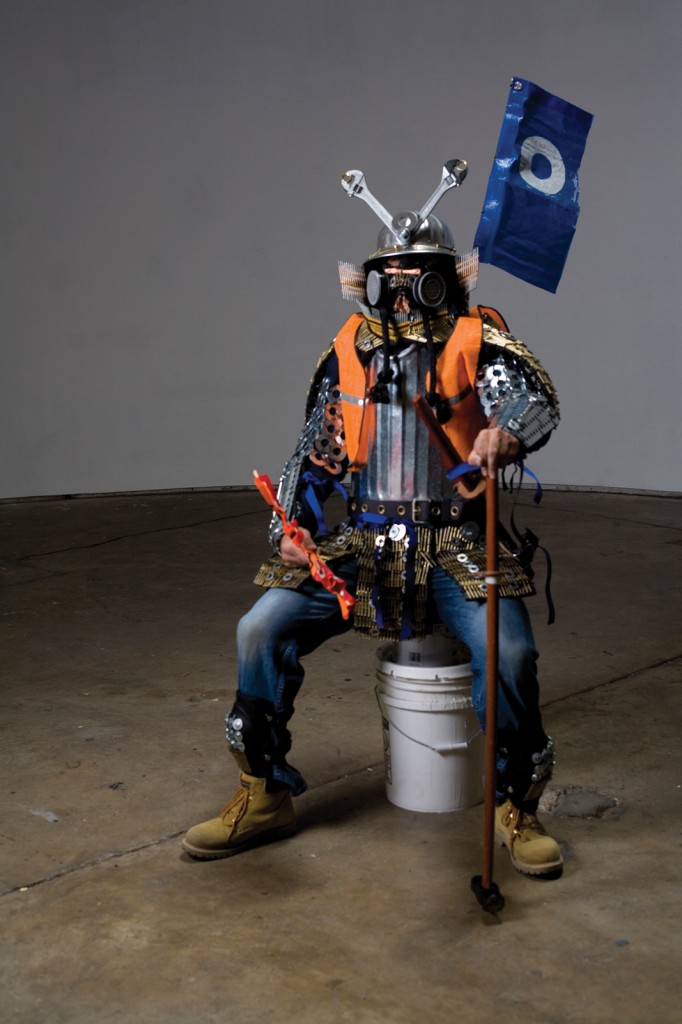
Jeremiah Jenkins "Blue Collar Bushido", hardware, industrial mats, mechanics jacket, trash can, varied dimensions
You’re from rural Tennessee originally. What was art to you growing up?
The refrigerator door. I didn’t have a concept of galleries or museums or fine art at all. Not until I went to college. That’s kind of my start, because even in high school it was like the renaissance, the guy worshipped Michelangelo and all that shit, old school. I learned how to paint and draw and stuff like that, but I’d never heard of conceptual art. Had never heard of anything like it and then I go to school. I go to college, because college is the way out of the valley, you know what I mean?
Where did you go to undergrad?
East Tennessee State, which is about an hour away from where I grew up. Which was like the big city in comparison. Johnson City, Tennessee, which I’m sure everyone’s heard of. Three Walmarts. My idea of art was very small, I didn’t know like—
You could think about it in terms other than a painting or drawing?
Yes. I remember the day when it happened. I was kind of thinking about quitting. I had some introduction to ideas and everything. But then I was in an art history class and I saw this artist, and I couldn’t remember the name at the time, but I remembered the piece. It was these giant blocks of ice in front of this gallery, and I was like, “Whoa”.
Paul Kos?
Yeah, it was Paul Kos; I didn’t even put that together, I had forgotten his name. And that really started it for me and that’s where I really started to enjoy it and just dive into it full steam. I had great teachers at ETSU that helped me develop that new energy, Catherine Murray, Don Davis. And then I graduated and I came to SFAI for grad school.
Did you take any time off?
I came right through because I wanted to get out of Tennessee, and it was the best way to get out, to go somewhere. The choice was either School of Visual Arts in New York and San Francisco Art Institute here. The School of Visual Arts in New York needed $1,000 by the 15th of the month to hold my spot, and SFAI needed $500 at the end of the month , so the choice was clear. And I wanted to come to California anyway. So I come to California and everybody’s saying, “Oh, there’s this guy, you should work with: Paul Kos, I think you’d like him.” I started looking up his work and it’s that guy. It’s the guy that put the ice in front of the gallery. To me that was what made the grad school experience worth it, was the teachers that I worked with and the people I met.
So you worked a lot under Paul, who were some of the other teachers that influenced you?
Well besides Paul, Sharon Grace and John Rolloff. I was a sculpture major, but I was right at that line with new genres because I was experimenting.
It seems after you graduated though, would you say that there was a jump when you kind of departed from sculpture, or started using sculpture in a more conceptual-based way?
I think I’ve always let the concept drive the sculpture. I think it was really personal changes that made me think a little different. In undergrad I learned how to work with stuff and I started out very political. My approach was that, “I’m going to expose the truth!” I’ve loosened up on that. I’ve loosened up on a lot of things. I realized that you don’t have to force your message so much, you know? Because then you might as well be yelling at people like a preacher or a protester. And that’s not what I’m trying to do. I’m trying to figure out how to say stuff and discover stuff that’s not on the surface. That I don’t even know that I believe right away.
I think that’s what art school does.
Well, it broke me down. Grad school broke me down from that yelling approach. I graduated, and I was in this space where there weren’t any firm rules, no more teachers, and I kind of checked out for a while. I needed to rest my soul and process so I could really apply the things that I had learned, as opposed to just going through the motions that you go through in school. I was big on not pigeonholing myself. I didn’t want to pigeonhole myself at all.
Into one style or medium?
I didn’t want to get into a formula, and I still struggle with this. I see myself doing something that’s similar to something I’ve done before and I’m like “no-no-no-no”.
From what I’ve noticed, I can always tell it’s your work when I see it, but it’s in very different mediums. Everything from wood burning to scale models.
I think people that know my work or really pay attention can tell it’s my work, but my last solo show, people were asking, “So which piece is yours?” Hatch Gallery, last year. Well, they we’re all mine, it was all just me. But that’s what keeps me interested in it.
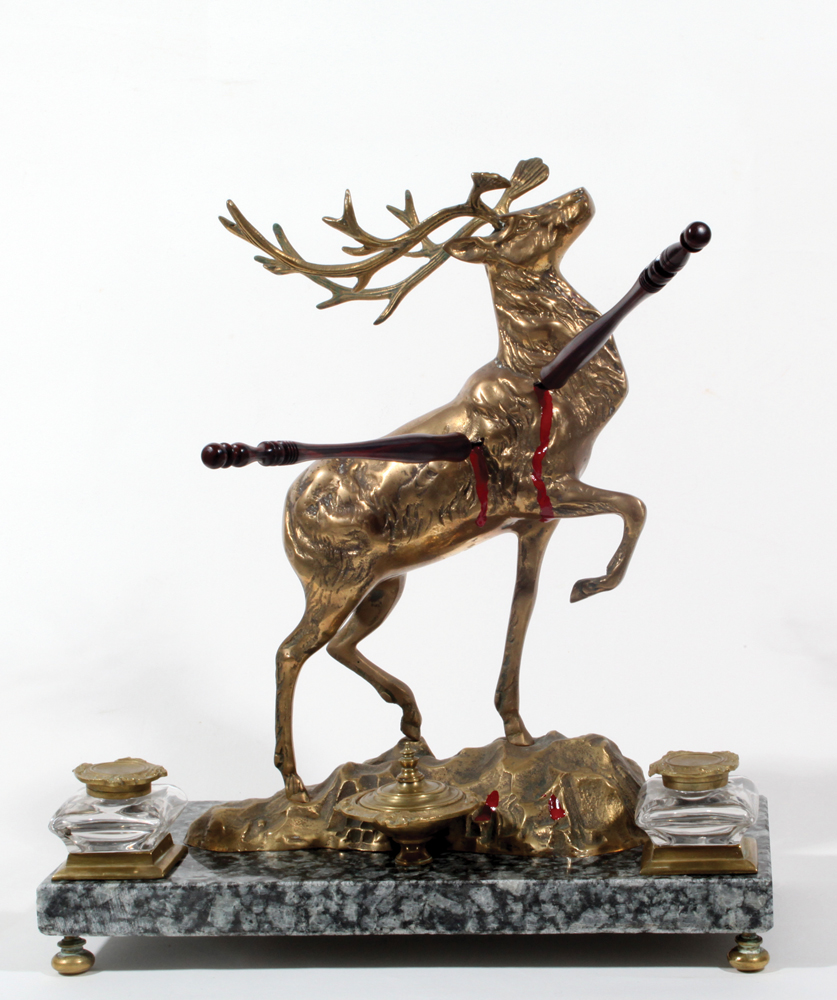
Jeremiah Jenkins, "Statesman's desk set", brass, granite, pens, inkwells, paint, 20"x4"x 15". Courtesy of the artist and Ever Gold Gallery
Before we started the tape recorder you were talking about a show you Judged recently and how art is meant to be this very pure thing that’s supposed to be joyful to participate.
I think the analogy I was making was it’s like basketball. You’ve got people who are professional basketball players who spend their whole life eating, breathing, living basketball. They train for it, they work for it, it’s all they want to do, it’s all they can do. Then you have the people that play on the weekends, or the people that are good, but don’t really think that they can be professional. And to be a professional artist, it’s like that. It’s even maybe a little bit harder than being a professional basketball player. Because if you’re a professional basketball player there are many different levels that you can play on. I guess it’s the same way with art, but to try and live off of it, it’s like being a professional basketball player, you know? And I judged this art contest that was up in Utica, New York, and it was, you know, how do I say this? A little weekend warriorish.
What was the age range?
I don’t know, I think like 18 to senior citizen. Some owls and trees and stuff, which, I don’t want to knock. There wasn’t much out of the box. There were maybe two things out of the box which were my number one and number two picks. But on the day that I went to go judge that art contest, I was walking to the place and I see this red string tied to a branch of a tree. It’s winter up there so everything’s grey. The string came down the tree and went on the ground. It was just strung across the ground, you know, about 15 feet of red string. And I was just totally captivated. I was like, “wow, is this someone’s piece?!”, “Is this the work for the contest?” And I watched it, I saw the way the lines went. It was beautiful, it was absolutely beautiful. And then I went to judge this art contest, and everyone was trying too hard. It didn’t come close to the string in the tree.
I love natural art phenomena, it gives me great joy to experience it because it reminds me of seeing art for the first time, like you get hit with that “thing”. I was at this fair and I was walking around, and there was this area that looked like a booth, but it wasn’t, but it was all white walls, and there’s this security guard in there with his back turned, making a phone call. I was like, “oh my god, is that—that’s amazing! What is that? That’s so cool!” That’s the only thing I really remember from this fair two years ago. But it’s those moments that make it special.
That’s how I cheat. Because I use found objects, right? Everything has a nature. I see an object and it gives me a sensation and that sensation leads me to the idea. And sometimes I’ll have the sensation without finding the object, and then have to find something that’s just got that same essence. I’m just trying to make things that seem like they already are. Seeing the hand in it is all right, but if you have a moment where you’re confused that’s the best. The fact that you didn’t know if the security guard talking on the phone was a piece or not, that’s great.
I would say that these ideas started with the conceptual art movement.
Yeah, totally, and then before that, Duchamp and all that.
Yes of course.
Right It’s all that stuff that made the ordinary world beauty acceptable. Then you can take that raw material from the world and just mix it together to point to the meaning or point to an idea or a message that you want to get across. I think of it like magic. It’s like you make the world. You take a thing and you do something to it to change the meaning or to change the ideas behind it so that when people see it they hear that subtle voice.
So you’ve also spent a lot of time in Oakland. You worked at Lobot Gallery for a while and have been around the Oakland art scene a lot, as well as the San Francisco art scene.
Rent’s cheaper.
Right but if you could, just do a quick comparison of the two, at least from your experience being involved with both scenes.
Well, San Francisco you’ve got the feeling of an establishment. Established galleries and you’ve got to kind of work your way in. There’s still do-it-yourself spaces, but it’s like they have to wear the clothes of the other places a little. It’s like the stoner that wears the tie to go to the job. It’s that kind of thing. In Oakland, it’s just a ripped t-shirt and jeans. You can do whatever you want.
Would you say there’s more creativity going on there in the gallery scene?
Raw creativity. That’s the thing about Oakland: it’s raw.
Which can be really good or…
Well, you know, there’s both sides of it. There’s some town somewhere in America where people are making raw folk art and it’s still creativity. They’re carving bears out of logs, but it’s…
It goes into what we were talking about in regards to the art judging competition.
Yeah. I feel like the art is defined by the place. And San Francisco is a tourist attraction fancy town. No one comes to vacation in Oakland. Oakland is like New York in the sixties. When they would talk about how dangerous it was and at the same time it’s a hotbed for art. Oakland is a place where artists go when they want to live in an industrial building, or they want to live an industrial life. But they don’t have to put on a show. You go to the art mumur there and everybody’s hanging out. It’s not like SF. And I feel like San Francisco gets a little bit more ridiculous every day with the rent prices, you see that a little bit in Oakland, and it’s starting, but man, it’s got a long way to go. I think it’s more about the attitude and the motivation in the two places.
So what’s the title for you upcoming solo exhibition at Ever Gold Gallery in May.
“Shit Doesn’t Have To Be So Fucked Up”
Amazing title. Actually before we get into that perhaps you can talk about your sculptural and performance based piece “Blue Collar Bushido” which you showed at Ever Gold in 2010 and more recently it travelled to NYC.
New York, LA, and now it’s in Walnut Creek at Bedford Gallery.
That piece is great because you’re wearing this fucking epic costume—well, you don’t wear it anymore.
I remember when I came up with the idea and I told you what I wanted to do and you said, “yeah, dude, I totally feel that. I was moving these chairs the other day and I just felt like this warrior.”
The idea of proletariat art, maybe, or the idea of labor in art.
Yeah, or just labor. I mean , we’ve got these people that carry our whole culture, our whole world on their backs literally in a lot of cases. They risk their lives, they risk all these things. Building, they build all these things that are supposed to be important to the infrastructure, right? And they can’t retire, they aren’t appreciated, it’s just ridiculous to me. What I wanted to do was a mix of capturing that idea of where you feel like a bad ass when you do that kind of work and also honoring those people.
Then you did that performance at Art PAD last year, where you smashed five cinder blocks, one for every work day while wearing the suite.
Yeah. What I loved was that not everybody noticed that I was doing a performance. Some people thought I was just breaking up cinder blocks. It’s like “yeah, I’m wearing a shiny suit of armor…”
How much does that thing weigh?
It’s only like 40-45 pounds, but it’s really uncomfortable. It’s like an oven, and it’s a lot harder to move around in than you think. It’s this weird spectacle and no one notices because of what I’m doing. Because I’m just doing work. “That was a performance?” “No, that’s our uniform. Our uniforms are samurai suits. We have the groundskeepers wear samurai suits while they clean up.” But you know what I love about that piece, and really, all my work, is when I see a guy like my dad walk in to the gallery and it’s like he doesn’t belong there, somebody dragged him along. Told him there would be free beer or free wine or something, right? And he’s just there to make people happy, doesn’t give a shit about art. And he looks at it and he goes, “Yeah, I get that.”
As someone who’s had to sit in a lot of art shows and watch gallery spaces and witnessed he flow of people into a gallery setting – well for example with some of the shows they have at Ever Gold are like –
You’re scared to come go in.
Yeah, what the fuck is this place? Last month it was Laundromat, this month it’s a punk venue, now…It’s completely different – it’s amazing to see the civilian (non gallery goer) get perplexed by art that can’t be described right away as art – they might walk by every few weeks and they get this total other experience about the show.
I see people walk by with that same look.
And they just stand there. It’s usually little kids or old people that freak out the most. They’re like “oh my god”. I enjoy that part, seeing their interactions with the shows, because it’s such an honest thing. It’s the same thing that you’re talking about.
People get turned off by art because they’ve been led to believe that it’s this thing that you have to understand. Sometimes it’s great, if you want to understand art and you want to know people and know all about it, then go for it, great. But you don’t have to. You can feel it, you can just see it. You can enjoy it, you can dislike it, you can do all those things and you don’t have to know shit. You know? That’s why street art is so popular, public art, all these things are getting popular because it appeals to everyone on a level that’s way more human than academic.
So you are going to be “Occupying” the upcoming artMRKT art fair in San Francisco in May as an official installation
Yeah, as .00000032%. Which is just me.
How did you make that calculation?
That’s the percentage that one person is of the total population of America. I got to a point where I found it hard to care. But now, today, It’s just…
Well after you try and fight the system for so long it becomes clear that it’s all bullshit you know?
I can see both sides of it. I was totally stoked when I saw people marching. Taking it to the streets and everything. And then at the same time , it’s like, not everybody who’s rich is an asshole, you know? But there are a lot of rich assholes. And somehow I’m rich, though I’m very poor.
There’s also a lot of nice rich people that buy art and support the arts in amazing ways – which is probably the best way to spend money these days for those reading this. Supporting culture is the most important thing anyone can do.
Right, and I love them. To see how it’s supposed to work and the fact that it doesn’t work, I mean, it’s people’s choice. If we really tore down everything it would be the wild west and whoever’s got the guns would all of a sudden be rich, you know what I mean? There’s got to be some middle ground, and I think the middle ground that I found is to live like you believe. If you don’t believe in something, don’t fucking pay it.
I mean, the way it’s set up is ridiculous. I was eighteen, actually I don’t think I was even eighteen yet when I got my first credit card application handed to me. I didn’t know shit. I was like Jed fucking Clampett off the farm. I didn’t know shit. My parents didn’t know shit. I think there needs to be changes to the system and I’m still not 100% sure that we’re not being run by fucking reptilian aliens that want to eat us and enslave us and make us mine gold! I’m still not sure of that. I mean, I wouldn’t be surprised either way. If they came out and said, “All right, we’re actually human, we’ve been trying to just develop civilization.” I’d be like, “All right.” If they came out and said, “We’re reptilians and we’re trying to make you into slaves…” I’d be like, “of course”. But don’t get me started.
So you’re going to be there at the fair, what is this performance going to look like?
I’m going to live there. I’m either going to wear a suit or a tuxedo and drink wine, but still live kind of rough. Because that’s the contradiction of life and of being an artist. It’s like, you live in a shit hole, you have to work your ass off, but then you’re at some gala with all these fancy people. I’ve drank gallons of wine, and I’ve eaten like pounds of fucking brie, you know? Who am I? I’m like this random guy from the country. I really won’t be protesting anything. I just want to be in the middle of everything, you know? Because it’s not that I don’t think the current state of affairs isn’t fucked up, I just don’t want to be part of that. I want to just exist.
That’s a nice little sound bite.
I say bring it home, you know? I mean, there’s ways to shape the world even from the alien overlords. You can shape your own world.
